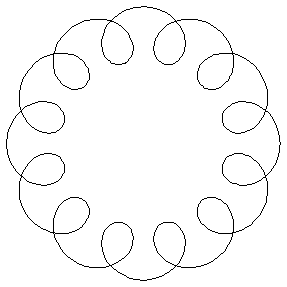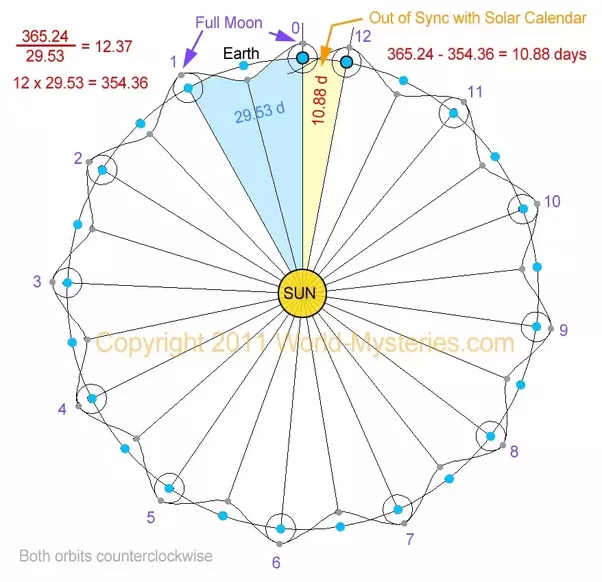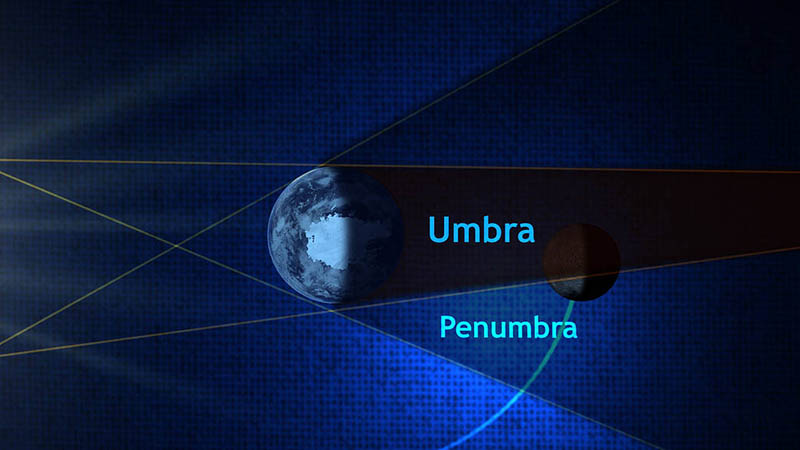Scale of the Earth and Moon:
Another thing we should do is clarify the relative scale of the earth and the moon. In all the images we have drawn they tend to be almost the same size. But are they? This is a question of ratios as we have been using in other parts of this course.
Dearth = 12,750 km and Dmoon = 3475 km. That means the ratio of their 'sizes' is Rmoon/Rearth = 3475 km/ 12,750 km = .27. This means the moon is a little over a 1/4 of the 'size' of the earth. Is this consistent with the drawings? Because what we notice in a drawing is the diameter or radius it is easy to overlook the fact that this also means that moon has only 1/64th the volume or mass of the earth.
The other scale question is the distance. The distance to the moon is 4.105 km so Dto moon/Dearth = 4.105 km/1.2.104 km = 33.3 - the moon is 33 diameters of the earth away.
In summary, we tend to be fairly close on the size of the moon in our drawings but way off on the scale of the distance.
Path of Earth and Moon:
Here's a question which seems (perhaps) obvious and really isn't. How does the moon, or does it, go around the earth? Draw the orbit of the earth around the sun and sketch the path you think the moon has as we both go around the sun.
Activity: In your groups sketch and compare your vision of how the earth and moon go around the sun. Then apply the guidance from the paragraphs below and see if that changes your sketch?
Redraw your picture of the orbit of the earth and divide it into 12 parts (roughly 12 months). Draw the location of earth at each of those 12 months. Now draw where the full moon is relative to the earth at each of those points. This will require being sure our previous discussions about moon phases are making sense.
Halfway in between each earth draw another earth and the location of the new moon relative to the earth. Since the moon moves smoothly through it's phases you should be able to connect the full moon to the new moon and make a continuous path around the sun. What does this make you think?
Did yours look like this initially? -- mine did the first time I did it (and many times after that!)

Here's more formal representation of what you just did....

...or the full cycle...

If you want to dig deeper here's a nice article from a hero of mine, Rhett Allain, about the topic of the moon's path around the sun.
Eclipses:
The last topic we need to explore is what all of this has to do with eclipses (what are they anyway?).
Lunar Eclipses:
What is this rumored to be? When the shadow of the earth covers the bright part of the moon.
Pull out the drawings you made for the phases of the moon. Where is the moon when there is at least the possibility it would pass throught the shadow of the earth? What is the phase of the moon when there is this possibility? If we are f2f we will build a model in class with balls of different sizes.
How often does it seem like there is an opportunity for there to be a lunar eclipse? Monthly seems reasonable given the phases of the moon. Does this match the data on this NASA website for lunar eclipses? NO!
Tilt of moon's orbit:
The 'orbit' of the moon around the is tilted (not lined up with) the plane of the earth's orbit around the sun. This means that some of the time the full moon is above the line of the earth-sun and sometimes it is below that line. In either case the shadow of the earth misses the moon. Notice in the lower half of the image below a scale illustration of what this means about the location of the moon relative to the plane of the earth and sun. Gives you a different sense than then pretty distorted but understanding sketch that is the upper half of the illustration.
Where is the sun in this picture? Would there be a possible lunar eclipse during the full moon as illustrated in this case?

The Frisbee Effect:
Because of their rotation frisbees maintain their tilt over large distances as they travel. For similar reasons the tilt of the orbit of the moon doesn't change during it's cycle around the sun. The moon's orbit is relatively stable in a similar way to the rotation axis of the earth. Here is what that looks like:

How often does this suggest we might get lunar eclipses (the labels on the image sort of give it away -- sorry). Does this match the NASA lunar eclipse calendar?
What is the next interesting inconsistency in the data? Yes the lunar eclipses are 6 months apart but why is it a different pair of months from year to year?
This is due to the procession of the orbit - the plane of the moon's orbit wobbles (9 or 18 yr cycle depending on which part of the process). That moves the month in which this all happens from year to year. What's amazing in part is that ancient peoples (think Stonehenge) figured out all of these cycles thousands of years ago.
Umbra and Penumbra:
These are two parts of the shadow of the earth cast into space. Hopefully we will be able to create an example of this using the projector in class. Here is an image from NASA -- what are the different lines illustrating? Even when the moon is in the umbra some light is bent through the atmosphere of the earth and provides a low level of light on the moon.

Activity: Looking at the previous illustration who can see a lunar eclipse when it happens? Use your stick figures on the surface of the earth to figure this out.
Take Away:
Lunar eclipses always happen during a full moon but only when the moon is 'level' with the earth and sun. This only typically happens 2x a year (6 months apart). Sometimes the moon doesn't quite get into the darkest part of the earth's shadow (the umbra). This leads to a penumbral eclipse.
Solar Eclipses:
How is a solar eclipse different? How often might you expect to have the possibility of a solar eclipse? How is the timing related to the lunar eclipses? How does this fit with the dates of solar eclipses from NASA? Does it fit a similar pattern?
Why is the experience of a solar eclipse so much more rare than a lunar eclipse? The moon is small and only those who are directly in line with the moon are in the shadow. A really important difference.
Here is a map of the locations where the eclipses are visible for the next while....
Open the table for lunar eclipses and solar eclipses (2021-2030) side by side. Look at the dates of each. You should see a pattern that fits clearly with what we have discussed.
HW: Eclipses
What is the phase of the moon during solar and lunar eclipses? Explain your reasoning clearly which probably requires a sketch.
HW: Eclipses
This video describes the mechanics of solar and lunar eclipses(direct link). How many times during a year is there a possibility of an eclipse? Is it different for lunar and solar eclipses? If the orbit of the moon was not tilted with respect to the earths orbit how many eclipses might we see in a year?
HW: Eclipses
Why is it more likely that we would have the opportunity to see a total lunar eclipse than a total solar eclipse?
HW: Eclipses
Find the NASA lunar and solar eclipse tables in the Breadcrumbs and Identify the date and time of the next total lunar eclipse that we can see from Central Oregon (what color will it be?). Identify the data, time, and location of the next total solar eclipse in the Western Hemisphere. I just want you to know so you can plan for future watch parties:)
Assignment: HW: Eclipses
Complete and assemble your solutions to all the HW problems listed here. Scan to a pdf and turn in on LMS. Please review HW format expectations for guidance about your homework solutions.
Reading Ahead:
Next time we will continue our explorations of the earth-moon system on the Sun, Earth, Moon II breadcrumb. This will get us started understanding eclipses and the actual path of the earth and moon around the sun.
